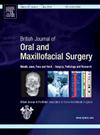Three-dimensional changes in the mandibular condyle in skeletal class III patients treated with orthognathic surgery: a systematic review
IF 1.7
4区 医学
Q3 DENTISTRY, ORAL SURGERY & MEDICINE
British Journal of Oral & Maxillofacial Surgery
Pub Date : 2024-12-01
DOI:10.1016/j.bjoms.2024.09.001
引用次数: 0
Abstract
This systematic review aimed to evaluate the available evidence on the incidence and quantification of 3-dimensional changes in mandibular condyles after orthognathic surgery by bilateral sagittal split osteotomy (BSSO), with or without maxillary surgery, in class III symmetrical or asymmetrical individuals. The databases PubMed, Lilacs, Web of Science, Embase, SciELO, Scopus, EBSCO, Cochrane, and Google Scholar were surveyed and the study was registered on the PROSPERO (CRD42022383594). The selected studies met the criteria established by the PICO model: 1: Population – individuals over 18 years of age with class III dentofacial skeletal deformities; 2: Intervention – orthognathic surgery using BSSO; 3: Comparison – condylar tomographic measurements (volume, thickness, height, and width) prior to the surgical procedure; and 4: Results – condylar tomographic measurements (volume, thickness, height, and width) at least 12 months after surgery. Initially, 800 articles were identified. After excluding 694 duplicates and screening 153, nine studies met the inclusion criteria for data extraction and analysis. Six evaluated class III symmetrical individuals, and three assessed those with mandibular asymmetry. A total of 233 patients (92 males and 141 females) were studied. Analysis of 466 condyles revealed minimal bone remodelling, with resorption averaging from −0.03 to −0.94 mm and apposition from 0.01 to 0.34 mm. Data analysis showed minimal changes in condylar morphology post BSSO with or without maxillary surgery, indicating predictable skeletal stability. Bias (ACROBAT-NRSI guidelines) did not affect data reliability, and no occlusal changes were observed. The main limitations of the study were heterogeneous imaging techniques, varied study designs, diverse populations, and inconsistent protocols. Further trials with standardised cone-beam computed tomography are needed to enhance remodelling and volume measurement reliability. This research received no specific grant from funding agencies in the public, commercial, or not-for-profit sectors.
接受正颌外科手术治疗的骨骼Ⅲ级患者下颌髁状突的三维变化:系统性综述。
本系统性综述旨在评估有关下颌髁状突三维变化的发生率和量化的现有证据,这些变化发生在通过双侧矢状劈开截骨术(BSSO)进行正颌手术(无论是否进行上颌骨手术)后的Ⅲ类对称或不对称患者身上。我们对 PubMed、Lilacs、Web of Science、Embase、SciELO、Scopus、EBSCO、Cochrane 和 Google Scholar 等数据库进行了调查,并在 PROSPERO(CRD42022383594)上进行了注册。所选研究符合 PICO 模型所设定的标准:1:人群--18 岁以上患有 III 级牙颌面骨骼畸形的人;2:干预--使用 BSSO 进行正颌手术;3:比较--手术前的髁突断层测量(体积、厚度、高度和宽度);4:结果--手术后至少 12 个月的髁突断层测量(体积、厚度、高度和宽度)。初步确定了 800 篇文章。在排除了 694 篇重复文章和筛选了 153 篇文章后,有 9 项研究符合数据提取和分析的纳入标准。其中 6 项研究评估了 III 级对称患者,3 项研究评估了下颌不对称患者。共有 233 名患者(92 名男性和 141 名女性)接受了研究。对466个髁突的分析显示,骨质重塑的程度很小,平均吸收量为-0.03至-0.94毫米,附着量为0.01至0.34毫米。数据分析显示,无论是否进行上颌骨手术,BSSO 术后髁状突形态的变化都很小,这表明骨骼的稳定性是可以预测的。偏差(ACROBAT-NRSI指南)没有影响数据的可靠性,也没有观察到咬合变化。该研究的主要局限性在于成像技术不尽相同、研究设计各异、研究对象不同以及研究方案不一致。为了提高重塑和体积测量的可靠性,需要进一步使用标准化锥形束计算机断层扫描进行试验。本研究未获得公共、商业或非营利部门资助机构的特别拨款。
本文章由计算机程序翻译,如有差异,请以英文原文为准。
求助全文
约1分钟内获得全文
求助全文
来源期刊
CiteScore
3.60
自引率
16.70%
发文量
256
审稿时长
6 months
期刊介绍:
Journal of the British Association of Oral and Maxillofacial Surgeons:
• Leading articles on all aspects of surgery in the oro-facial and head and neck region
• One of the largest circulations of any international journal in this field
• Dedicated to enhancing surgical expertise.

 求助内容:
求助内容: 应助结果提醒方式:
应助结果提醒方式:


